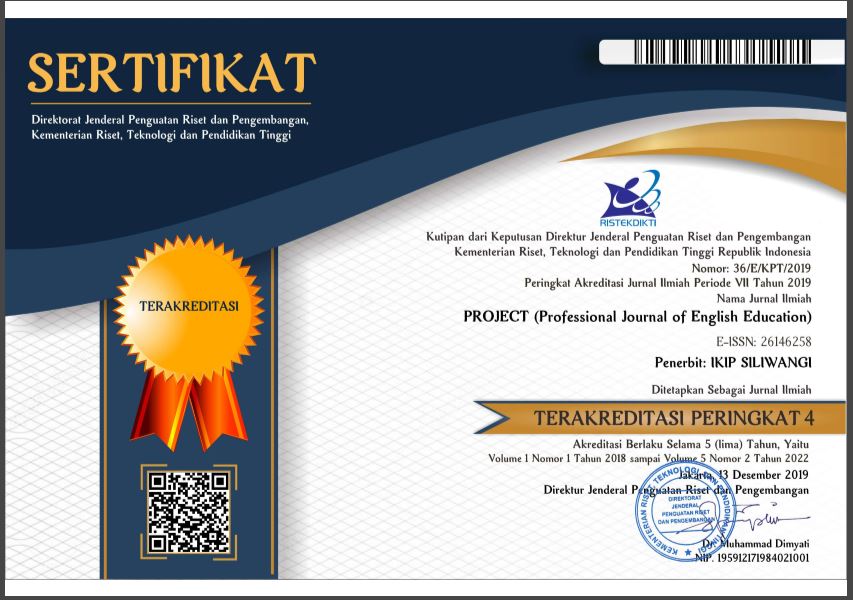LEXICAL COHESION OF JOE BIDEN’S SPEECH IN PHILADELPHIA: A DISCOURSE ANALYSIS
Abstract
In discourse analysis, speech was defined as a form of communication involving the production and expression of spoken language. In this study, researchers used spoken language, namely speech. This study aims to discover the types of lexical cohesion in Joe Biden’s speech in Philadelphia. The researchers applied Brian Paltridge’s theory, which divides lexical cohesion into six types: antonymy, collocation, synonymy, repetition, meronymy, and hyponymy. The qualitative method was used to carry out this study. The data collection method is observation with a note-taking technique by watching and listening to the data source. The analyzing data method is identification with an identity technique by classifying the data that have been collected. Results of this study, the researchers found 20 data related to the forms of lexical cohesion. There are 7 data containing antonymy, 1 data containing collocation, 3 data containing synonymy, and 9 data containing repetition. Repetition is a strategy of lexical cohesion that Joe Biden employed frequently to emphasize his points in each line of his statements. The researchers did not find the data related to meronymy and hyponymy, because there were no data related to part of a whole or no data showing a relationship between general and specific.
References
Afzaal, M., Hu, K., Chishti, M. I., & Imran, M. (2019). A study of Pakistani English newspaper texts: an application of Halliday and Hasan’s model of cohesion: a discourse analysis. International Journal of English Linguistics, 9(5). https://doi.org/10.5539/ijel.v9n5p78
Agustian, A., & Arsyad, S. (2023). An analysis of comparative lexical cohesion between BBC news and Jakarta post news. Journal of English for Specific Purposes in Indonesia, 2. https://doi.org/doi.org/10.33369/espindonesia.v2i2.25853
Asif, M., Zhiyong, D., Malik, A. H., Roohi, S., & Saeed, A. (2020). Lexical functions and cohesion in Imran Khan’s speech on 28 September 2019 at United Nations General Assembly. International Transaction Journal of Engineering, Management, & Applied Sciences & Technologies. https://doi.org/10.14456/ITJEMAST.2020.320
Baker, P., & Ellece, S. (2011). Key terms in discourse analysis (1st ed.). Continuum International Publishing Group.
Batubara, H. M., Rahila, D. I. C., & Ridaini, R. (2021). An analysis lexical cohesion in Jakarta post news. Journal of Linguistics, Literature and Language Teaching, 1. https://doi.org/10.37249/jlllt.v1i1.278
Creswell, W. J., & Creswell, D. J. (2018). Research design: qualitative, quantitative, and mixed methods approaches. (5th ed). SAGE Publications, Inc.
Enyi, U. A., & Chitulu, O. M. (2015). Texture, textuality and political discourse: a study of lexical cohesion in Nigeria’s President Goodluck Jonathan’s inaugural address, may, 2011. Advances in Language and Literary Studies, 6. https://doi.org/10.7575/aiac.alls.v.6n.5p.77
Farnia, M., & Kabiri, N. (2020). Cross-cultural study of Lexical cohesion in Political newspaper articles. Language Art, 5. https://doi.org/10.22046/LA.2020.24
Habibah, N., & Sulistiyo, U. (2018). The analysis of lexical cohesion in National column as found in the Jakarta post newspaper. Jambi English Language Teaching, 3. https://doi.org/10.22437/jelt.v3i1.6583
Halliday, M. A. ., & Hasan, R. (1976). Cohesion in English (R. Quick (ed.)). Longman Group Ltd.
Mandarani, V., & Fakhruddin, Z. M. (2020). Grammatical and lexical cohesion analysis of Trump’s speech upon Soleimani assassination. Journal Basis, 7. https://doi.org/10.33884/basisupb.v7i1.1753
McCarthy, M. (1991). Discourse analysis for language teachers (1st ed.). Cambridge University Press.
Merriam, B. S., & Tisdell, J. E. (2016). Qualitative research : a guide to design and implementation (4th ed). John Wiley & Sons, Inc.
Mirzapour, F., & Ahmadi, M. (2011). Study on lexical cohesion in English and Persian research articles (a comparative study). English Language Teaching, 4(4). https://doi.org/10.5539/elt.v4n4p245
Nuzulia, L. F. I., & Wulandari, I. (2020). An analysis of lexical cohesion in Donald Trump’s speech to the UN General Assembly 2017. Center of Language and Cultural Studies, 5. https://doi.org/10.30957/ijotl-tl.v5i1.635.
Paltridge, B. (2022). Discourse analysis: an introduction (K. Heyland (ed.); Third). Bloomsbury.
Putri, N. K. A. A. (2022). An analysis of lexical cohesion found in “photograph” song lyrics. Linguistics Initiative, 2. https://doi.org/10.53696/27753719.2133
Sinaga, N. T., Sagala, H., Hutabarat, U. E., Sinaga, J. A., & Nababan, J. (2022). The lexical cohesion found in the educational article of Jakarta post. Pioneer: Journal of Language and Literature, 14. https://doi.org/10.36841/pioneer.v14i1.1689
Wahyuni, R., & Oktaviany. (2021). Lexical and grammatical cohesion in The Lion King movie script. English Teaching and Linguistics Journal (ETLiJ), 2(1).
Yule, G. (2010). The study of language (4th ed.). Cambridge University Press.
Downloads
Published
Issue
Section
License

This work is licensed under a Creative Commons Attribution-ShareAlike 4.0 International License.




